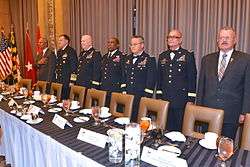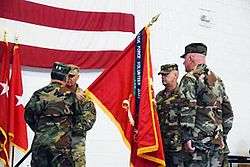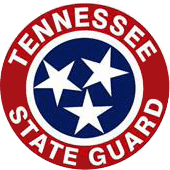Tennessee State Guard
| Tennessee State Guard | |
|---|---|
|
The Tennessee State Guard insignia | |
| Active | 1985 - Present |
| Country |
|
| Allegiance |
|
| Type |
|
| Role | Military reserve force |
| Size | 200+ (Cadre Strength) |
| Part of | Tennessee Military Department |
| Garrison/HQ | Nashville, TN |
| Website | http://www.tnmilitary.org/tennessee-state-guard.html |
| Commanders | |
| Civilian Leadership |
Governor Bill Haslam Governor of the State of Tennessee |
| State Military Leadership |
Major General Terry M. "Max" Haston Commanding General, Tennessee State Guard |
The Tennessee State Guard (TNSG) is the state defense force of the state of Tennessee. The TNSG is organized as an all-volunteer military reserve force whose members drill once per month unless called to active duty. The TNSG is a branch of the Tennessee Military Department, alongside the Tennessee Army National Guard, the Tennessee Air National Guard, and the Tennessee Emergency Management Agency. The State Guard acts as a force multiplier for the state's National Guard. As a state defense force, the Tennessee State Guard cannot be federalized, and is not deployed outside the borders of Tennessee, as it is a purely state-level unit. It answers solely to the Governor of Tennessee, unlike the dual federal and state controlled National Guard. The creation of a state military force is recognized under Tennessee Code Annotated 58-1-401.[1]
History
State militias
The Tennessee State Guard traces its origins to the American Revolution. During the Battle of King's Mountain, approximately four hundred volunteers from the area known today as Tennessee crossed the mountains into North Carolina to fight against the British Army and Loyalist militias. They contributed significantly to the Patriot victory.
Tennessee militias served in battle again in the War of 1812 under Andrew Jackson. After fighting and winning the Battle of Horseshoe Bend (1814), they served with distinction in the Battle of New Orleans alongside other state militias, federal soldiers, local volunteers, slaves, and pirates against the British Army.[2]
During the Mexican-American War, the nickname "The Volunteer State" became associated with Tennessee. When asked by President Polk to provide two infantry regiments and one cavalry regiment, Tennessee provided approximately ten times that number of volunteers.[3]
During the American Civil War, the Confederacy took advantage of the many state-based militias to fight their war. Tennessee's location on the border of Kentucky, which was a Union state, and the strategic hub of Memphis, Tennessee made the residents of Tennessee in constant need of forces to protect them from Union incursions. Tennessee volunteer units served in many battles of the Civil War, notably the Battle of Shiloh in which the 4th Tennessee Infantry served with distinction and lost nearly half of its members.[4]
During the Reconstruction Era, violent activity by the Ku Klux Klan and former Confederate partisans led Governor William G. Brownlow to establish the Tennessee State Guard as a state militia to counter these anti-Reconstruction efforts. The Tennessee State Guard was a coalition drawn from white Unionists and Radical Republicans, as well as black freedmen; seven companies contained black soldiers, including one commanded entirely by black officers.[5]:31 During the Reconstruction Era, the Tennessee State Guard was used “to police elections, protect recently enfranchised freedmen, and thwart the operations of paramilitary groups such as the Ku Klux Klan.”[5]:dust jacket
World War I
After the passage of the Militia Act of 1903, state militias were transformed into the National Guard, and subject to deployment by the federal government. In order to maintain a military presence within the state for homeland security purposes after their National Guard units were federalized and deployed abroad during World War I, states were forced to create independent State Guard units aside from their National Guard. Many states did so during World War I in order to be prepared for missions such as guarding borders and coastlines, suppressing possible insurrections, guarding military establishments, and responding to disasters. In 1915, Tennessee created a paramilitary unit, the Tennessee Rangers, which was organized as a constabulary unit and fell under the authority of the adjutant general. In 1916, the Rangers were deployed to end the burning and destruction of properties in Stewart County by the Ku Klux Klan. The Rangers helped maintain order during World War I while the National Guard was deployed abroad until their disbandment in 1923.[6]
World War II
In 1941, prior to the United States' entrance into World War II, the Tennessee State Guard was reinstated by Governor Prentice Cooper. The State Guard received training and direction from the federal military, with approximately 100 officers spending two weeks training under army officers at Fort Oglethorpe in Georgia. Within a year, Tennessee’s State Guard became the fifth largest in the United States, the largest in the South and the largest state guard in proportion to its population.[7] One famous Tennessean, Alvin York, belonged to the World War II-era Tennessee State Guard, accepting a commission as a colonel in 1941.[8] The State Guard was activated numerous times, including guarding a Boeing B-17 Flying Fortress which was forced to make an emergency landing outside of Pulaski, Tennessee; maintaining peace after a riot in Bristol, Tennessee; performing relief effort following a train crash in Jellico, Tennessee; and assisting in the pursuit and capture of three escaped German prisoners from Camp Forrest.[7] By 1947, with National Guard units returning home, the State Guard went inactive.
1985-present
In 1985, the Tennessee Defense Force was reactivated to provide a trained military reserve force for the Governor to call upon in times of emergency, and, in 1998, the name was changed by the legislature to the Tennessee State Guard.[4] In 1993, the TNSG was deployed to assist in recovery operations following a series of tornadoes which touched down in Tennessee.[9] After the attacks of September 11, 2001, state guard members were called up to guard a federal naval station in Millington, Tennessee. In 2005, Governor Phil Bredesen activated the Tennessee State Guard to assist with relief efforts from Hurricane Katrina.[10]
Duties

The organization's responsibilities are summarized in the mission statement of the Tennessee State Guard, namely: "The purpose of the Tennessee State Guard is to provide a professional complement of personnel to support the State mission of the Tennessee National Guard, by assisting the Tennessee Army National Guard as a force multiplier, and at the direction of the Adjutant General, to assist civil authorities with disaster relief, humanitarian causes, ceremonial service, religious and medical support for the well being and safety of the citizenry of Tennessee."[11]
The Tennessee State Guard can be used to augment National Guard units in times of emergency, provide medical aid, security, funeral honors, high frequency (HF) communications and perform other stateside responsibilities generally performed by the Tennessee National Guard. The State Guard can serve as first responders to a natural or man-made disaster, and may integrate emergency response plans with local community emergency response teams. Aside from deploying to aid victims of Hurricane Katrina, and guarding military installations in the aftermath of the September 11 attacks, State Guardsmen, in preparing for their role as emergency response personnel, also participated in Operation Vigilant Guard in a disaster response drill organized as a mock earthquake disaster zone.[4] Since the state guard is not a federal force, it is not prohibited from engaging in law enforcement by the Posse Comitatus Act, unlike federal military units. As the Tennessee State Guard generally provides non-combat support for the National Guard or state civilian authorities, guardsmen are not armed during duty, although no law exists which prevents them from being armed on the governor's orders.
Although the TNSG performs unarmed support roles during deployment, members of the TNSG regularly compete in the Mid-South Guard & Reserve Association M16 rifle and Beretta M9 pistol marksmanship competitions against Army, Navy, Air Force, Marine Corps, and Coast Guard reservists as well as members of the National Guard.
In 2014, at the request of the 194th Engineer Brigade of the Tennessee Army National Guard, several National Incident Management System (NIMS)-certified instructors from the 1st Regiment of the Tennessee State Guard provided NIMS training to members of the 194th Engineer Brigade over a two-day training period. The State Guard plans to continue providing emergency management training to National Guardsmen based in other cities.[12]
Membership
Any able-bodied citizen with a high school diploma or GED and no criminal record is eligible for membership, although preference is given to honorably discharged members of all five branches from the United States military. Civilians with specific professional skill sets, such as doctors, attorneys, chaplains or engineers, may be given preference for membership without prior military service.[13] All officers must have at minimum earned a bachelor's degree.[13]
Training

New personnel with no prior military service are required to attend Initial Entry Training (IET) during their first year, usually held concurrently with Annual Training (AT). Prospective members are required to take several free online emergency management classes offered by the Federal Emergency Management Agency in order to earn the Military Emergency Management Specialist Badge. Tennessee State Guard training includes classes from the Tennessee Emergency Management Agency (TEMA).[14] The Tennessee State Guard also provides online training courses through the TNSG Academy. Training is conducted during drill days, which are held one day per month, and during an annual three-day drill during the summer.[1]
All of the TNSG basic non-commissioned officer and basic officer courses are approved through the United States Army Training and Doctrine Command at Fort Monroe, Virginia. In 2015, the Tennessee State Guard initiated in-residence courses to include Advanced Leaders Course (ALC), Officer Basic Course (OBC) and Warrant Officer Basic Course (WOBC). These courses are generally conducted once per year concurrently with Annual Training (AT).[15]
In 2010, the Tennessee State Guard launched a four month military police class, with regiments from East Tennessee taking part in the pilot program taught at the Knoxville Police Headquarters.[16]
Uniforms
The TNSG uses the battle dress uniform in the woodland camouflage pattern as its uniform.[17] Members are also authorized to wear the Tactical Response Uniform (TRU) in Woodland Pattern. This uniform is similar in design to the Army Combat Uniform (ACU), only in different color pattern. In the event that Tennessee State Guardsmen are assigned to work with the Tennessee National Guard as members of a flight crew, Guardsmen are authorized to wear the aircrew battle dress uniform (ABDU) if prescribed by the commander.[18] For formal events, including military funerals and award ceremonies, the Dress Blue or Army Service Uniform (ASU) is optional for Guardsmen.[17]
Organization
The Tennessee State Guard is organized as a Directorate Headquarters with four regiments. The headquarters are based in Nashville, Tennessee. Offices and directorates reporting directly to headquarters include:[19]
- Directorate of Personnel Administration
- Directorate of Plans, Operations and Training
- Directorate of Security and Intelligence
- Directorate of Logistics
- Directorate of Civil/Military Support
- Directorate of Communications
- Directorate of Engineering Services
- Directorate of Information Services
- Headquarters Commandant
- Headquarters Surgeon Section
- Secretary to the General Staff
- Judge Advocate General Staff
- Office of the Inspector General
- Provost Marshal
- TNSG Academy
- Public Information Office
- Chaplains
The battalions of the TNSG are divided into four larger units: the 1st Tennessee Regiment, based in Millington; the 2nd Brigade Support team, based in Nashville; the 3rd Tennessee Regiment, based in Knoxville; and the 4th Tennessee Regiment, based in Chattanooga.[19]
| Regiment/Brigade | Battalion Name | Location |
|---|---|---|
| First Regiment | 1st Infantry Battalion | Millington |
| 2nd Military Police Battalion | Jackson | |
| 3rd Military Police Battalion | Trenton | |
| 4th Military Police Battalion | Paris | |
| Second Brigade Support Team | 51st Forward Support Battalion | Nashville |
| 3rd Tennessee Regiment | 1st Infantry Battalion | Gray |
| 2nd Military Police Battalion | Jefferson City | |
| 3rd Military Police Battalion | Kingsport | |
| 4th Military Police Battalion | Alcoa | |
| 4th Tennessee Regiment | 1st Infantry Battalion | Chattanooga |
| 2nd Military Police Battalion | Cleveland | |
| 3rd Military Police Battalion | McMinnville | |
| 4th Military Police Battalion | Winchester | |
Legal protection
Like National Guardsmen and federal reservists, state guard members receive protection from termination or other forms of discipline from their employers as a result of being called into active duty or drill status under Tennessee Code Annotated § 8-33-110.[20]
Awards and decorations
In addition to several ribbons issued by the TNSG, Tennessee State Guardsmen are allowed to wear decorations issued by other military institutions, including ribbons, decorations, and badges issued by the following institutions in order of precedence:[21]
- Awards from the seven Uniformed services of the United States, which includes the five branches of the United States Armed Forces (both federal and reserve), the United States Public Health Service, and the National Oceanographic and Atmospheric Administration
- Awards from foreign nations approved for wear by the U.S. Armed Forces
- Awards issued by the Tennessee Army or Air National Guard, or a different state's National Guard
- Tennessee State Guard awards
- Civil Air Patrol awards
- Coast Guard Auxiliary awards
- Awards from other authorized state defense forces (pending approval from the TNSG commanding general)
- Awards from the State Guard Association of the United States
State Guardsmen who have earned the Combat Infantry Badge, the Parachutist Badge, the Ranger tab, the Pilot Wings, the Air Crewman Wings, the Submarine Warfare insignia, the Diver insignia, the SEAL Trident, or other awards or badges while in federal service may wear them on the TNSG uniform as prescribed by the United States Army uniform regulations.[21]
Individual ribbons
The Tennessee State issues the following awards:[21]
TNSG Valor Ribbon
TNSG Alvin C. York Ribbon
TNSG Distinguished Service Ribbon
TNSG Meritorious Service Ribbon
TNSG Com. Gen. Letter of Commendation Ribbon
TNSG Commendation Ribbon
TNSG Wound Ribbon
TNSG Life Saving Ribbon
TNSG Officer Achievement Ribbon
TNSG Enlisted Achievement Ribbon
 TNSG TN Defense Service Ribbon
TNSG TN Defense Service Ribbon TNSG Search & Rescue Ribbon
TNSG Search & Rescue RibbonTNSG Aid to Civil Authority Ribbon
 TNSG Operation Desert Storm/Shield Ribbon
TNSG Operation Desert Storm/Shield RibbonTNSG Operation Enduring Freedom Ribbon
TNSG Operation Task Force Volunteer Ribbon
TNSG Community Volunteer Service Ribbon
TNSG Soldier of the Year Ribbon
TNSG Good Conduct Ribbon
TNSG Officer Training
TNSG NCO Training Ribbon
TNSG Basic Entry Level Training
 TNSG Chaplain's Ribbon
TNSG Chaplain's RibbonTNSG Volunteer Service Ribbon
 TNSG Recruitment Achievement Ribbon
TNSG Recruitment Achievement RibbonTNSG Recruiter's Ribbon
TNSG Military Readiness Ribbon
TNSG Service Ribbon
See also
- Naval militia
- Tennessee Air National Guard
- Tennessee Wing Civil Air Patrol
- United States Coast Guard Auxiliary
References
- 1 2 "The All-Volunteer Tennessee State Guard". Tennessee State Guard Official Website. Retrieved 13 October 2013.
- ↑ "Tennessee State Library and Archives: Brief History of Tennessee in the War of 1812".
- ↑ "How Tennessee became the "Volunteer" State". www.tennesseehistory.com. Retrieved 13 October 2013.
- 1 2 3 "A Volunteer Army of Tennessee Pre-Dates the United States". Tennessee State Guard Official Website. Archived from the original on January 12, 2014. Retrieved 13 October 2013.
- 1 2 Severance, Ben (2005). Tennessee's Radical Army: The State Guard and its Role in Reconstruction, 1867-1869. University of Tennessee Press. ISBN 1572333626.
- ↑ Stentiford, Barry M. (2002). The American Home Guard: The State Militia in the Twentieth Century. Texas A&M University Press. pp. 70–71. ISBN 1585441813. Retrieved 4 December 2014.
- 1 2 "Tennessee State Guard". Tennessee Virtual Archives. Tennessee State Library and Archives. Retrieved 4 December 2014.
- ↑ Hickman, Kennedy. "World War I: Sergeant Alvin C. York". www.about.com. Retrieved 13 October 2013.
- ↑ Tulak, Arthur N.; Kraft, Robert W.; Silbaugh, Don. "State Defense Forces and Homeland Security" (PDF). Retrieved 25 December 2013.
- ↑ Carafano, James Jay; Brinkerhoff, John R. (October 5, 2005). "Katrina's Forgotten Responders: State Defense Forces Play a Vital Role". www.heritage.org. Retrieved 13 October 2013.
- ↑ "Tennessee State Guard". Tennessee State Guard Official Website. Retrieved 13 October 2013.
- ↑ "Soldiers of the TNSG Conduct a NIMS Two-day Training Session for 29 Soldiers of the 194th Engineering Bridgade" (PDF). State Guard Association of the United States. Tennessee State Guard. Retrieved 19 December 2014.
- 1 2 "Join the Tennessee State Guard". Tennessee State Guard Official Website. Archived from the original on January 12, 2014. Retrieved 13 October 2013.
- ↑ "The Tennessee State Guard". The Tennessee Encyclopedia of History and Culture. Tennessee Historical Society & University of Tennessee Press. 2010.
- ↑ Bankus, Lieutenant Colonel Brent C. "Volunteer Military Organizations: An Overlooked Asset". The U.S. Army Official Website. Retrieved 1 April 2014.
- ↑ Butera, Steve (August 7, 2010). "Tennessee State Guard starts up new military police class". www.wbir.com. Retrieved 14 October 2013.
- 1 2 "Questions & Answers about the Tennessee State Guard". Third Regiment of the Tennessee State Guard Official Website. Retrieved 24 October 2013.
- ↑ "TNSG Regulation 670-1: Dress and Appearance" (PDF). First Regiment of the Tennessee State Guard Official Website. Archived from the original (PDF) on October 29, 2013. Retrieved 24 October 2013.
- 1 2 3 "Tennessee State Guard Units". Tennessee State Guard Official Website. Archived from the original on January 12, 2014. Retrieved 13 October 2013.
- ↑ "State of Tennessee Public Chapter No. 390 Senate Bill No. 1996" (PDF). www.tn.gov. Retrieved 13 October 2013.
- 1 2 3 "TNSG Command Operational Policy 672-5" (PDF). 2nd MP Battalion, 3rd Regiment, Tennessee State Guard Official Website. Archived from the original (PDF) on September 17, 2012. Retrieved 9 January 2014.
External links
- The Tennessee State Guard Website
- History of the Tennessee State Guard during World War II on the Tennessee Virtual Archive
